BOX
September 2013 ––
While collaborating with the insanely mad geniuses at Bot & Dolly in beautiful San Francisco, Munkowitz was tasked to Design Direct a truly unique piece called BOX. The piece was originally supposed to function as a Technology Demo, but munkowitz and the team quickly realized it's visual potential and transformed it into a Design and Performance Piece.
The resulting short film is a one-of-a-kind visual and technological achievement due to the very special combination of talent and gear behind the doors of the B&D facility, and was received throughout the world with unexpected accolades and exposure online and on the festival circuit – all due to the intense amount of love and passion poured into the project.
The resulting short film is a one-of-a-kind visual and technological achievement due to the very special combination of talent and gear behind the doors of the B&D facility, and was received throughout the world with unexpected accolades and exposure online and on the festival circuit – all due to the intense amount of love and passion poured into the project.
The Film
–– 01The Concept
–– Projection The piece was essentially grounded on the Principles of Stage Magic, invoking five of the basic categorizations of Illusionary. These Categories greatly informed the conceptual and aesthetic foundation and were fused with a graphic design aesthetic heavy in Minimalistic Forms and Illuminated Fractal Geometry.
This direction was then placed into a projection-based Physical Installation, where all the 'magic' was captured live and in-camera, filmed documentary-style with no post effects or treatment to make it feel authentic and real. In essence the immense technology behind the curtain being completely masked from the viewer by the methods used to capture the performance.
This direction was then placed into a projection-based Physical Installation, where all the 'magic' was captured live and in-camera, filmed documentary-style with no post effects or treatment to make it feel authentic and real. In essence the immense technology behind the curtain being completely masked from the viewer by the methods used to capture the performance.
–– 02
The Design Approach
–– Theory of Illusion in DesignThe Design Approach for the film was to have the Graphics be informed by Black and White Optical Illusion Art as the primary visual catalyst. It made sense that visually, if the piece was to be founded on the Principles of Magic and Illusionary, that the Graphics would also fit into this Theory of Illusion in Design. This aesthetic was applied to all the artwork within the BOX and it's evolution throughout the piece as the Principles are explored, interchanging between shaded Volumetric Graphics and Self-Illuminated Geometry.
Secondly, the Lighting Design and Filming Style was greatly informed by the Film Noir aesthetic of the 40's and 50's, utilizing a Black and White palette and highly stylized, minimal lighting to paint a very theatrical image; as it made sense from a design aesthetic to pay homage to that period for a piece founded on such a timeless art form as magic.
Lastly, the final piece of the puzzle was to score a soundscape that contributed to the psychedelic nature of the design; to essentially build an emotional arc throughout the piece as it transitions from mysterious objects within the Box, through a brightly lit and exposed technology demo, and ultimately culminating as fully realized performance art. A myriad of Analog Synthesizers were used by the master himself Soviet Rouge, which fit perfectly with the Conceptual cues and Visual Palette of the piece.
Secondly, the Lighting Design and Filming Style was greatly informed by the Film Noir aesthetic of the 40's and 50's, utilizing a Black and White palette and highly stylized, minimal lighting to paint a very theatrical image; as it made sense from a design aesthetic to pay homage to that period for a piece founded on such a timeless art form as magic.
Lastly, the final piece of the puzzle was to score a soundscape that contributed to the psychedelic nature of the design; to essentially build an emotional arc throughout the piece as it transitions from mysterious objects within the Box, through a brightly lit and exposed technology demo, and ultimately culminating as fully realized performance art. A myriad of Analog Synthesizers were used by the master himself Soviet Rouge, which fit perfectly with the Conceptual cues and Visual Palette of the piece.
–– 03

Transformation
–– Chapter 01The first principle of Magic explored in the piece is Transformation, where the BOX is transformed from one state into another, much like a silk handkerchief changing color, or the typical card trick changing from one suit to another.. In this case, the Transformation was achieved by having the BOX react first to the character's touch and gesture, and then its movement, rendering the Geometry and Volume of the Box being subdivided by these actions.
A variety of visual styles were explored, interchanging between Shaded graphics, Op Art, Illuminated Cubes and Wireframes.
A variety of visual styles were explored, interchanging between Shaded graphics, Op Art, Illuminated Cubes and Wireframes.
–– 04


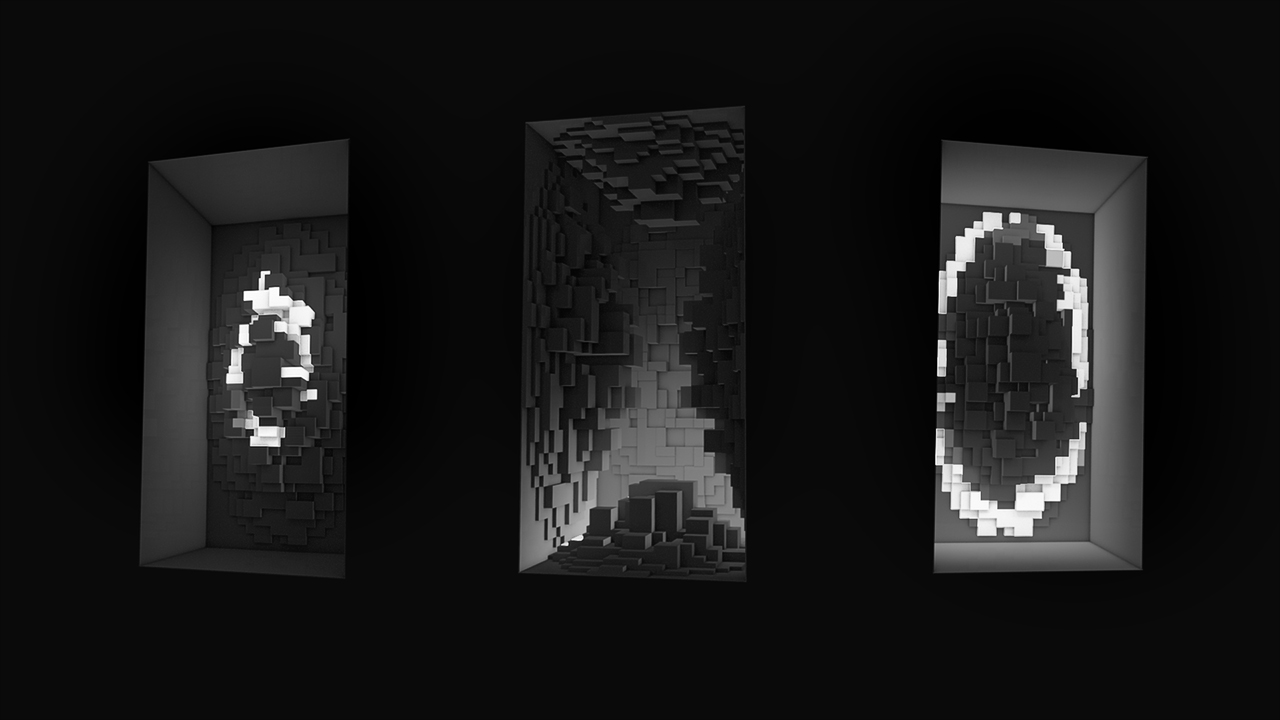






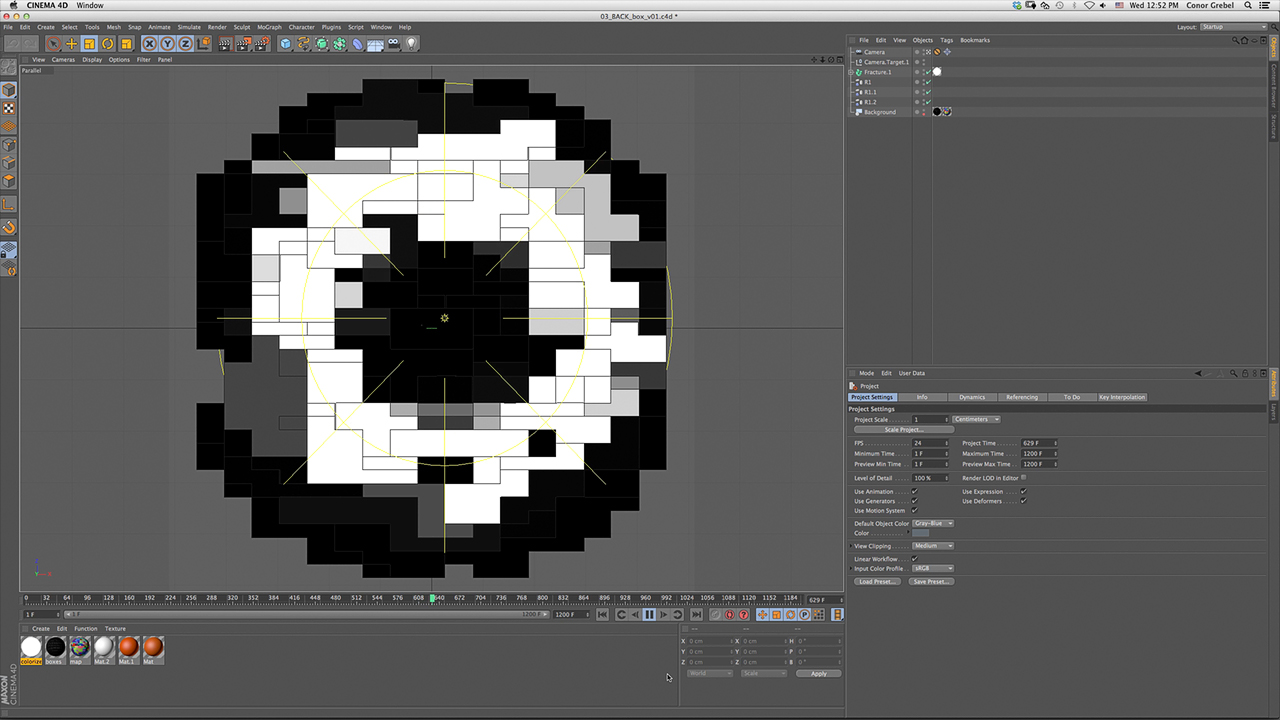

Levitation
–– Chapter 02The second principle of Magic is Levitation, where much like the magician defies gravity and hovers a few inches off the floor, the canvas starts to lift off the ground and touch on the surreal. Another canvas is introduced and together a flock of spheres interact with an Illuminated Tunnel, rendering the illusion of objects levitating and passing from one canvas to another.
Towards the end of the section, the spheres return as one ultra-powered ElectroSphere, which is the visual climax of the section while touching on the theme of Restoration, another Principle of Magic.
Towards the end of the section, the spheres return as one ultra-powered ElectroSphere, which is the visual climax of the section while touching on the theme of Restoration, another Principle of Magic.




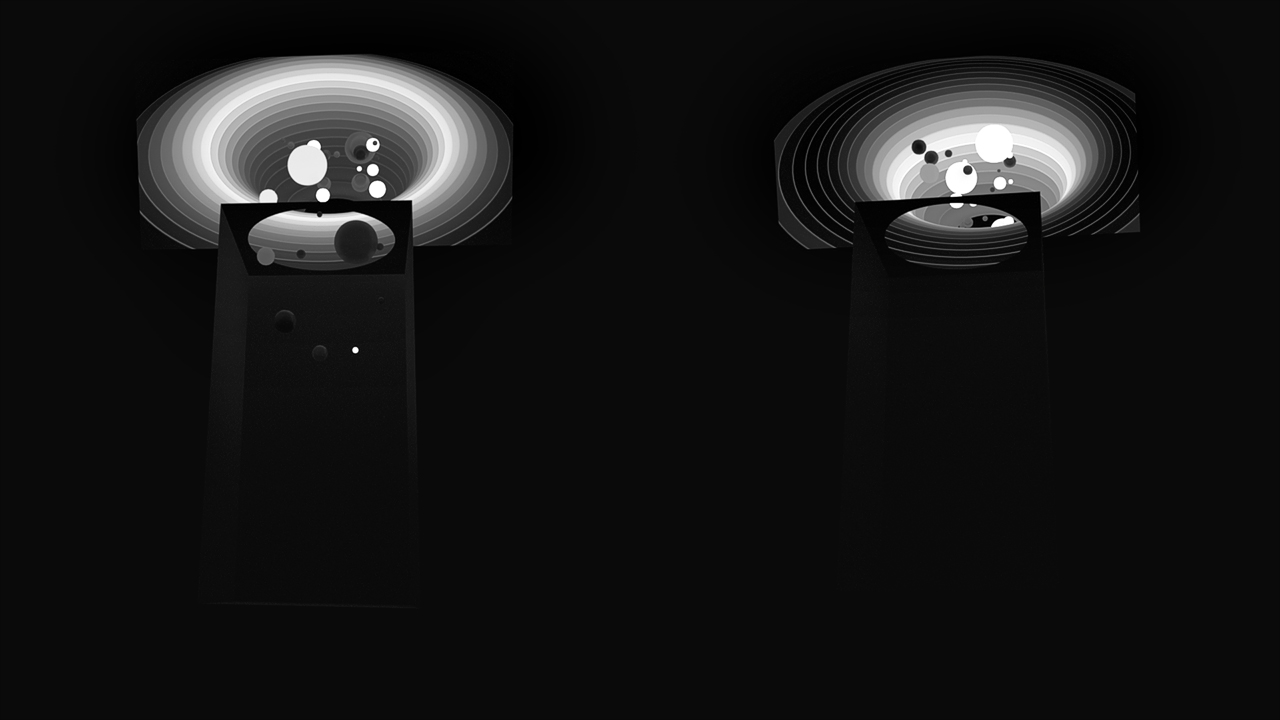

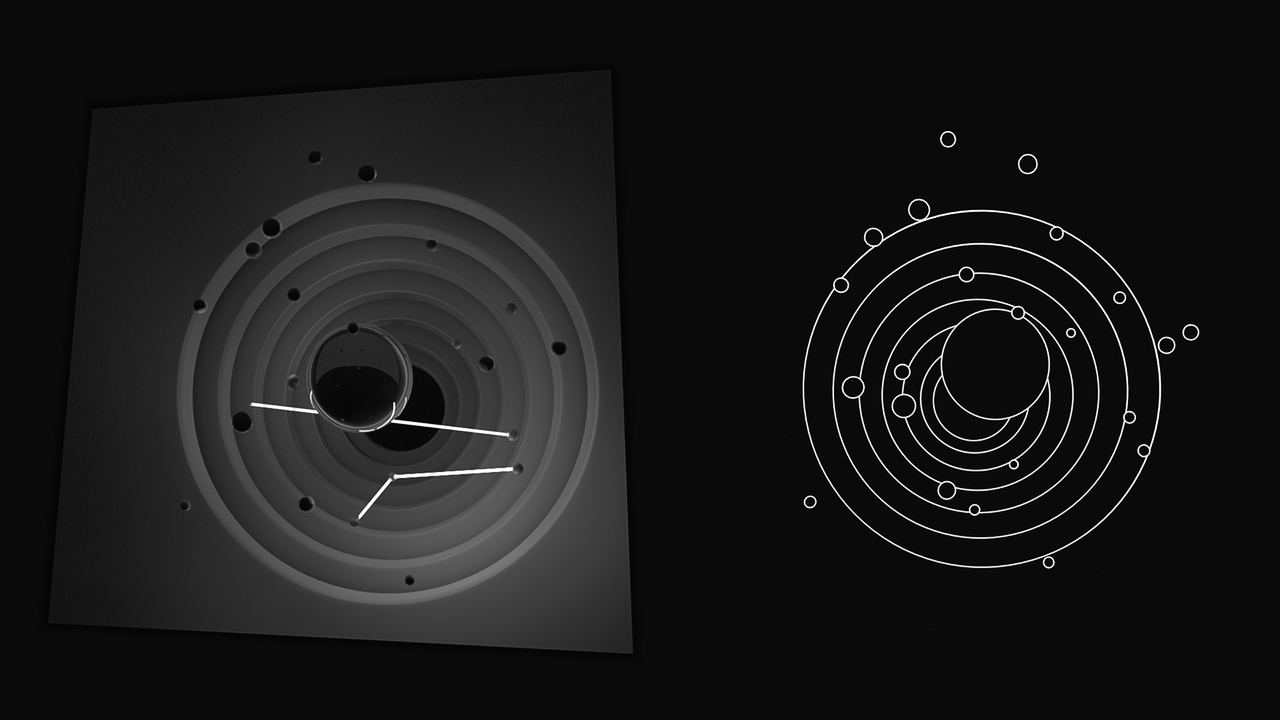







Intersection
–– Chapter 03The third principle of Magic is actually called Penetration, but since we're all a bunch of boys we couldn't really deal with that title, so the term 'Intersection' was used to keep everyone grown-up. For this principle, which is founded on the concept of one object passing through another – ie a set of steel rings link and unlink, or swords passing through an assistant in a basket – the graphic solution was to have two canvases interacting with each other while rendering the visual 'Solid-through-Solid' effect.
So by utilizing a shared center region of Intersection, a myriad of graphic extrusions and recesses were rendered to create depth and intrigue while executing this Principle of Magic.
So by utilizing a shared center region of Intersection, a myriad of graphic extrusions and recesses were rendered to create depth and intrigue while executing this Principle of Magic.





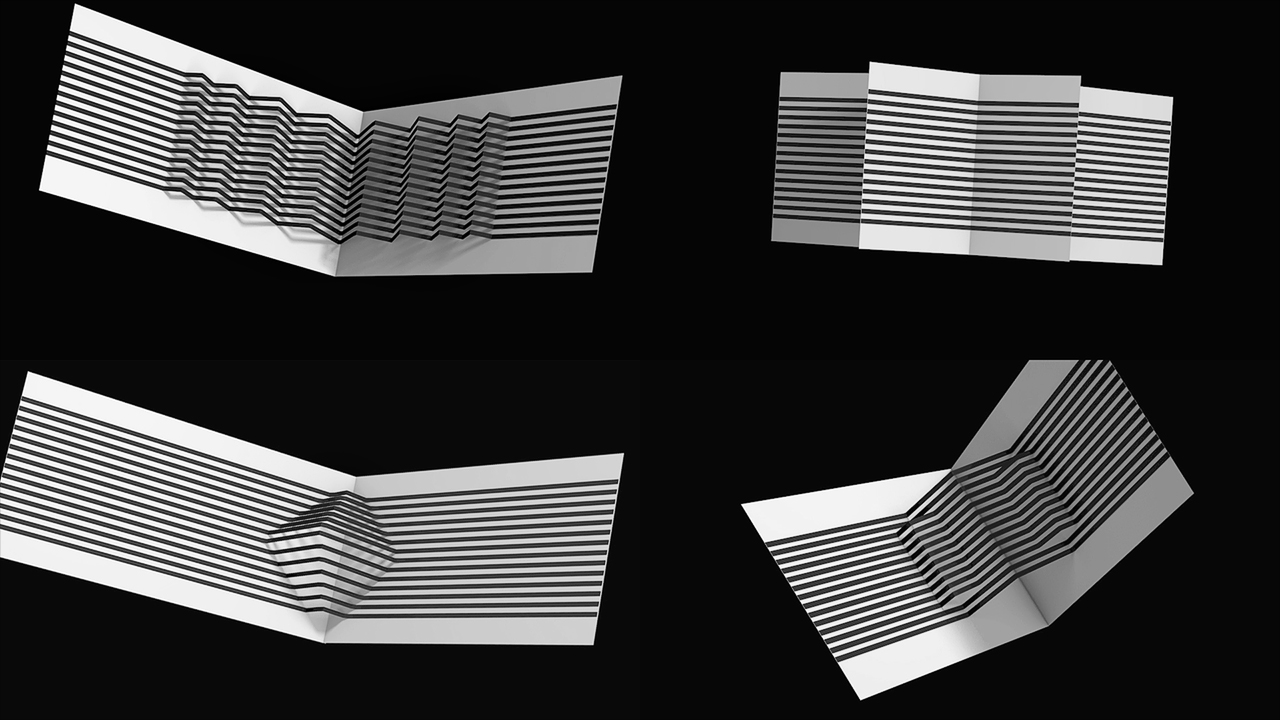





Teleportation
–– Chapter 04The fourth principle of Magic is Teleportation, where the magician causes something to move from one place to another—a borrowed ring is found inside a ball of wool, a canary inside a light bulb, an assistant from a cabinet to the back of the theatre, a coin from one hand to the other etc. Within this section, a Prism continually duplicates itself with each appearance state, eventually turning into a Dodecahedron that is then Transported between the canvases in a flurry of Robotic Motion.
Ultimately, the Dodecahedron becomes a light object and travels through a long, deep hallway, ultimately breaking apart once again and dropped into a deep chasm projected on the floor.
Ultimately, the Dodecahedron becomes a light object and travels through a long, deep hallway, ultimately breaking apart once again and dropped into a deep chasm projected on the floor.








Escape
–– Chapter 05The fifth and final Principle of magic, by definition, is when the magician is placed in a restraining device (i.e., handcuffs or a straitjacket) or a death trap, and escapes to safety. Examples include being put in a straitjacket and into an overflowing tank of water, and being tied up and placed in a car being sent through a car crusher.
In the application of the BOX Demo, the character is 'captured' by the unified Canvas geometry, and is then revealed within the Box, where the character is then transported within the volume as Geometric light is cast behind him. In a fitting crescendo, a giant diamond portal is revealed where the character Escapes the volume by traveling down the Passageway, the interactive lighting catching his limbs as he is swept away to Salvation.
In the application of the BOX Demo, the character is 'captured' by the unified Canvas geometry, and is then revealed within the Box, where the character is then transported within the volume as Geometric light is cast behind him. In a fitting crescendo, a giant diamond portal is revealed where the character Escapes the volume by traveling down the Passageway, the interactive lighting catching his limbs as he is swept away to Salvation.
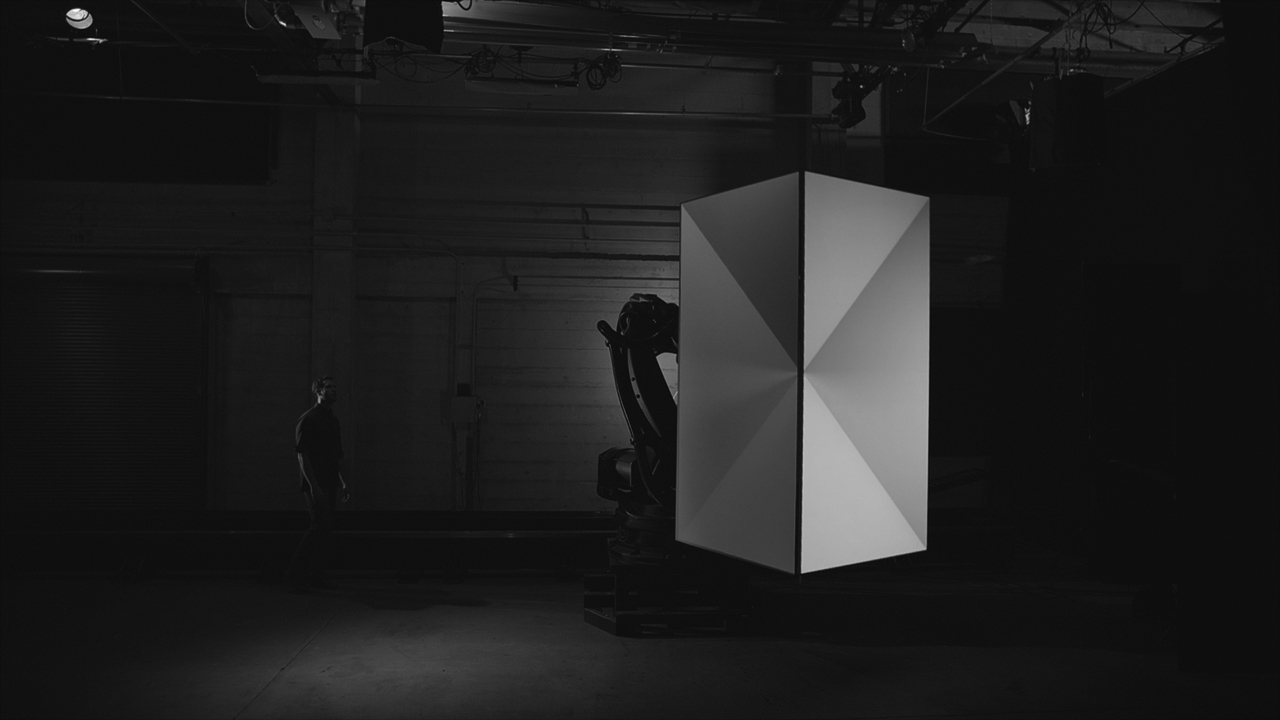










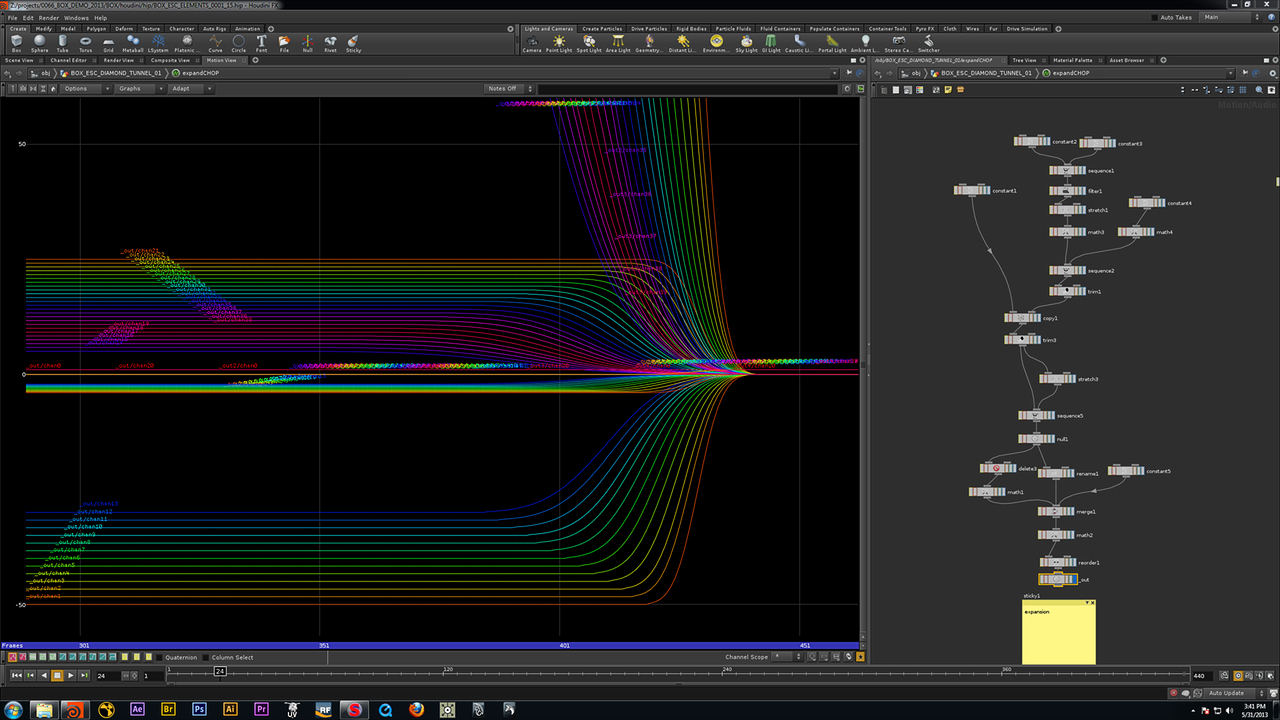
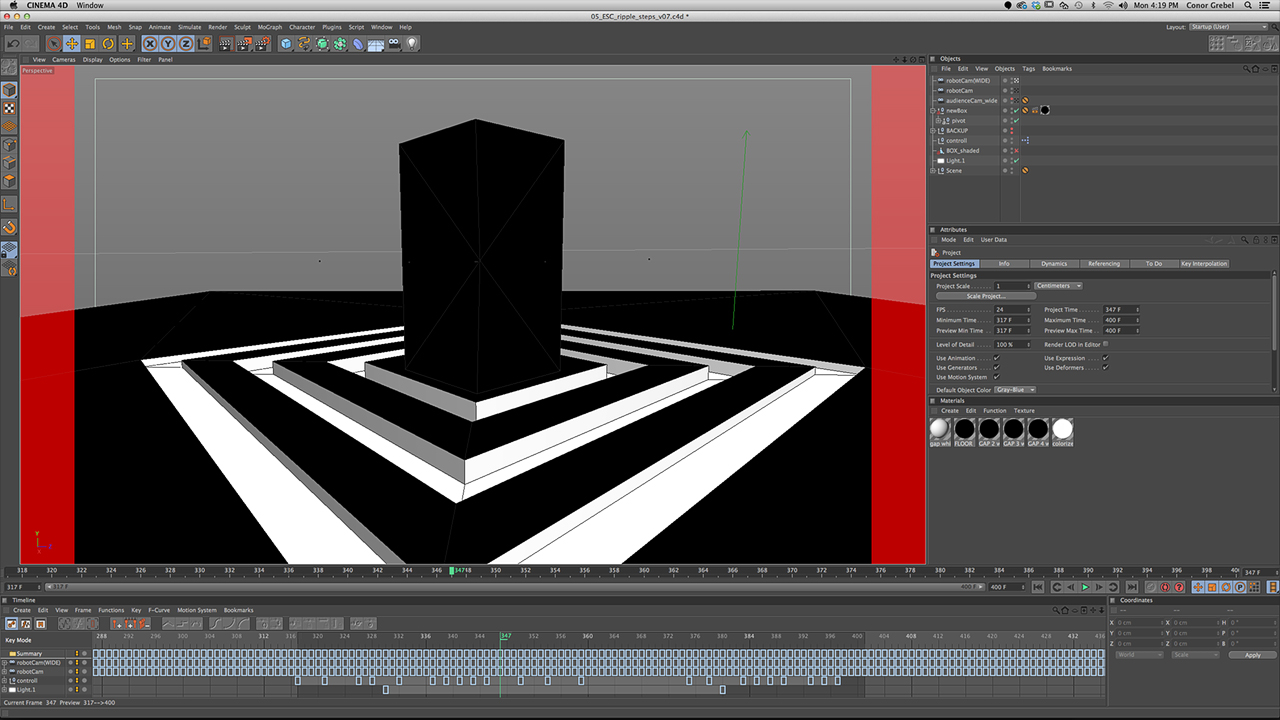

The Process
–– Mix of IndustriesThe process for making the piece was quite involved, combining conventional graphic design and animation tools with robotics animation, projection mapping, automated cinematography and a grip of other technologies unique to the studio. The task of getting the graphic design to first integrate with the robotic moves within the physical space, and then to maintain its visual fidelity when projected required many iterations, since what looks good on screen doesn't always translate to projected and filmed artwork.
In the end, a fairly sophisticated system was devised to render the designs almost exactly as intended; and the shit-hot 4K projector didn't hurt matters either. For more information, The Creator's Project has a lovely featurette about the project worth checking out.
In the end, a fairly sophisticated system was devised to render the designs almost exactly as intended; and the shit-hot 4K projector didn't hurt matters either. For more information, The Creator's Project has a lovely featurette about the project worth checking out.
–– 09
The Memories
–– Kids Having FunThis team was one of the best to date, and not just because of the immense talent within each members respective expertise. With all of the long hours and challenging creative during the reviews with Uncle Jeff, this team always bound together, trusted one another and had some fuckn' fun along the way.
As a result, this delightful dance ensemble was cut to present the spirit of the project, masterfully edited by the one-and-only Ian Colon – they sure did love that PhaseSpace Calibration Wand. It was so much fun making this incredibly rich project; one of the best ever. Ever.
As a result, this delightful dance ensemble was cut to present the spirit of the project, masterfully edited by the one-and-only Ian Colon – they sure did love that PhaseSpace Calibration Wand. It was so much fun making this incredibly rich project; one of the best ever. Ever.
–– 10
Press Links
SIGGRAPH –– BOX Wins SIGGRAPH 2014 Best In Show
Computer Arts | Showcase –– Building a projection-mapped box of tricks
AvantGarde –– Bot & Dolly's Box receives Silver Lion at Cannes
The One Club –– Gold Pencil Design / Bot & Dolly
Vimeo: Vimeo Presents –– Top 10 Videos of 2013
The Creator's Project –– [Best of 2013] The Year In Creativity: BOX
The Creator's Project –– [Video Premiere] Projection Mapping And Robots Combine In Bot & Dolly's New Film
Webby Awards –– BOX Webby Award Winner - Experimental & Weird
IO9 –– BOX Projection Mapping Next Level
Wired –– Augmented Reality - projection-mapping on moving objects
Devour –– BOX Featured Film - Projection Mapping
Colossal –– A Groundbreaking Demonstration at the Intersection of Robotics, Projection-Mapping, and Software
Motionographer –– Bot & Dolly - Box
Computer Arts | Showcase –– Building a projection-mapped box of tricks
AvantGarde –– Bot & Dolly's Box receives Silver Lion at Cannes
The One Club –– Gold Pencil Design / Bot & Dolly
Vimeo: Vimeo Presents –– Top 10 Videos of 2013
The Creator's Project –– [Best of 2013] The Year In Creativity: BOX
The Creator's Project –– [Video Premiere] Projection Mapping And Robots Combine In Bot & Dolly's New Film
Webby Awards –– BOX Webby Award Winner - Experimental & Weird
IO9 –– BOX Projection Mapping Next Level
Wired –– Augmented Reality - projection-mapping on moving objects
Devour –– BOX Featured Film - Projection Mapping
Colossal –– A Groundbreaking Demonstration at the Intersection of Robotics, Projection-Mapping, and Software
Motionographer –– Bot & Dolly - Box
BOX Credit List
Production Company: BOT & DOLLY
Executive Producers: Bill Galusha, Nick Read
Executive Creative Director: Jeff Linnell
Creative & Technical Director: Tarik Abdel-Gawad
Design Director: Bradley G Munkowitz
Lead Graphic Designers: Bradley G Munkowitz, Jason English Kerr
3D Artists: Scott Pagano, Bradley G Munkowitz, Jason English Kerr, Conor Grebel
2D Artists: Conor Grebel, Ben Hawkins, Pedro Figuera
Director of Photography: Joe Picard
Lighting Designers: Joe Picard, Phil Reyneri
Projection / Touch Designer: Phil Reyneri
Robotics Animation: Tarik Abdel-Gawad, Brandon Kruysman, George Banks, Michael Beardsworth
Robotics Operator: Michael Beardsworth, Brandon Kruysman
Prop Fabrication: Matt Bitterman, Ethan Dale
Script Supervisor: Ian Colon
Sound Engineers: Joe Picard, Michael Beardsworth
PAs: Sean Servis, Dakota Smith, Nico Mizono, Eric Wendel, Patrick Walsh
Editors: Ashley Rodholm, Ian Colon
Music / Sound Design: Keith Ruggiero
Sound Mix: Joel Raabe
Performers: Tarik Abdel-Gawad, Iris, Scout
Production Company: BOT & DOLLY
Executive Producers: Bill Galusha, Nick Read
Executive Creative Director: Jeff Linnell
Creative & Technical Director: Tarik Abdel-Gawad
Design Director: Bradley G Munkowitz
Lead Graphic Designers: Bradley G Munkowitz, Jason English Kerr
3D Artists: Scott Pagano, Bradley G Munkowitz, Jason English Kerr, Conor Grebel
2D Artists: Conor Grebel, Ben Hawkins, Pedro Figuera
Director of Photography: Joe Picard
Lighting Designers: Joe Picard, Phil Reyneri
Projection / Touch Designer: Phil Reyneri
Robotics Animation: Tarik Abdel-Gawad, Brandon Kruysman, George Banks, Michael Beardsworth
Robotics Operator: Michael Beardsworth, Brandon Kruysman
Prop Fabrication: Matt Bitterman, Ethan Dale
Script Supervisor: Ian Colon
Sound Engineers: Joe Picard, Michael Beardsworth
PAs: Sean Servis, Dakota Smith, Nico Mizono, Eric Wendel, Patrick Walsh
Editors: Ashley Rodholm, Ian Colon
Music / Sound Design: Keith Ruggiero
Sound Mix: Joel Raabe
Performers: Tarik Abdel-Gawad, Iris, Scout